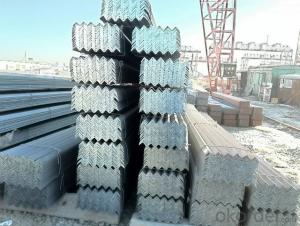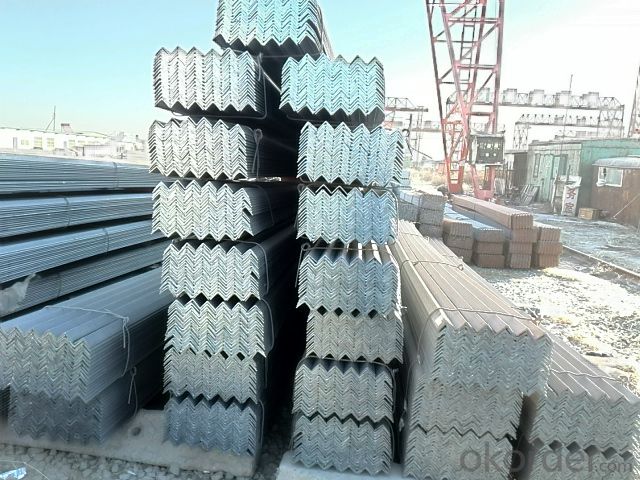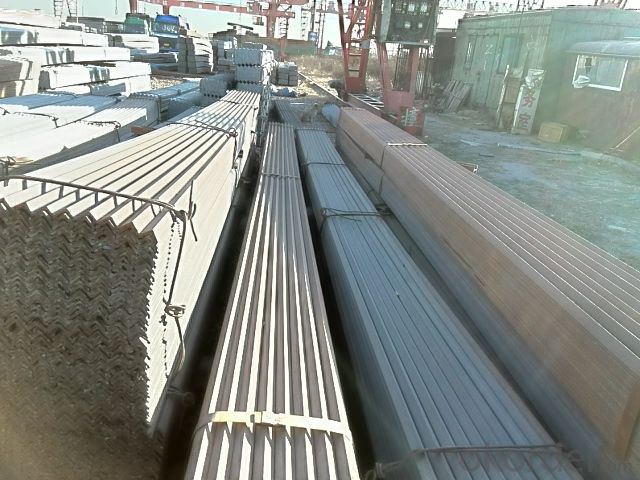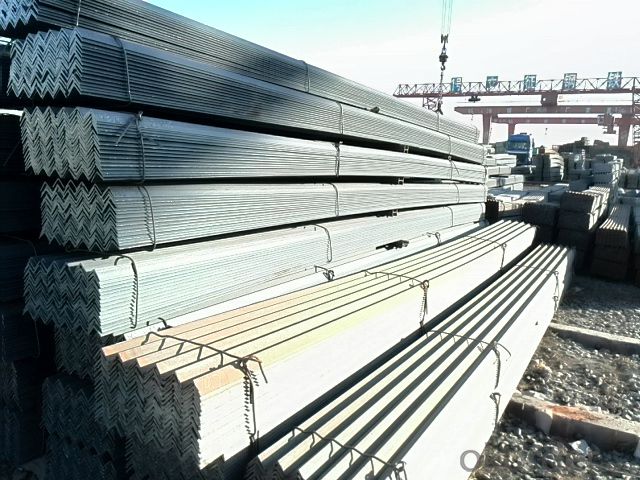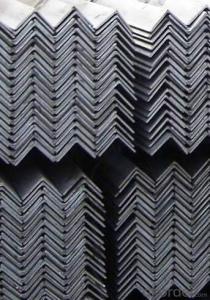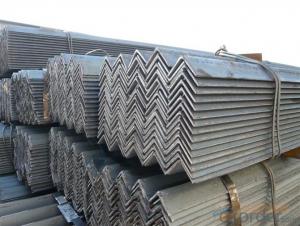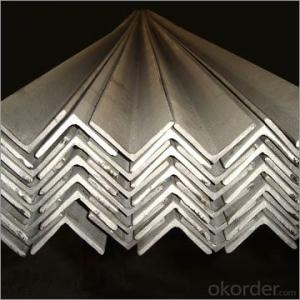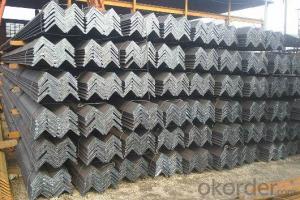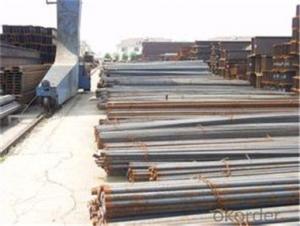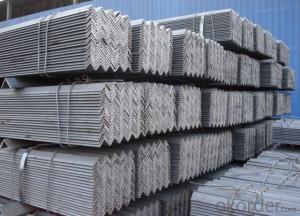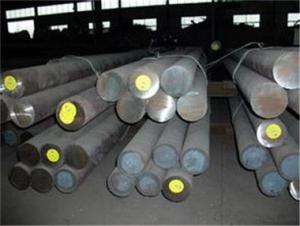Steel Angle Bars Hot Rolled Source from China
- Loading Port:
- Tianjin
- Payment Terms:
- TT OR LC
- Min Order Qty:
- 25 m.t
- Supply Capability:
- 10000 m.t/month
OKorder Service Pledge
OKorder Financial Service
You Might Also Like
Specification
Okorder.com is a professional materials & equipment supplier & manufacturer, offers integrated one-stop services including real-time quoting and online cargo tracking. We are funded by CNBM Group, a Fortune 500 enterprise and the largest materials & equipment firm in China.
Product Applications:
According to the needs of different structures, Angle can compose to different force support component, and also can be the connections between components. It is widely used in various building structures and engineering structures such as roof beams, bridges, transmission towers, hoisting machinery and transport machinery, ships, industrial furnaces, reaction tower, container frame and warehouse etc.
Product Advantages:
OKorder's Steel Angles are durable, strong, and resist corrosion.
Main Product Features:
· Premium quality
· Prompt delivery & seaworthy packing (30-45 days after receiving deposit)
· Corrosion resistance
· Can be recycled and reused
· Mill test certification
· Professional Service
· Competitive pricing
Product Specifications:
1. Invoicing on theoretical weight or actual weight as customer request
2. Length: 6m, 9m, 12m as following table
3. Sizes
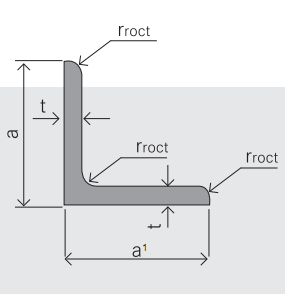
Sizes: 25mm-250mm | ||
a*t | ||
25*2.5-4.0 | 70*6.0-9.0 | 130*9.0-15 |
30*2.5-6.6 | 75*6.0-9.0 | 140*10-14 |
36*3.0-5.0 | 80*5.0-10 | 150*10-20 |
38*2.3-6.0 | 90*7.0-10 | 160*10-16 |
40*3.0-5.0 | 100*6.0-12 | 175*12-15 |
45*4.0-6.0 | 110*8.0-10 | 180*12-18 |
50*4.0-6.0 | 120*6.0-15 | 200*14-25 |
60*4.0-8.0 | 125*8.0-14 | 250*25 |
4.Material details:
Alloy No | Grade | Element (%) | |||||
C | Mn | S | P | Si | |||
Q235 | B | 0.12—0.20 | 0.3—0.7 | ≤0.045 | ≤0.045 | ≤0.3 | |
Alloy No | Grade | Yielding strength point( Mpa) | |||||
Thickness (mm) | |||||||
≤16 | >16--40 | >40--60 | >60--100 | ||||
≥ | |||||||
Q235 | B | 235 | 225 | 215 | 205 | ||
Alloy No | Grade | Tensile strength (Mpa) | Elongation after fracture (%) | ||||
Thickness (mm) | |||||||
≤16 | >16--40 | >40--60 | >60--100 | ||||
≥ | |||||||
Q235 | B | 375--500 | 26 | 25 | 24 | 23 | |
FAQ:
Q1.What's your payment terms ?
A1:1)100% irrevocable L/C at sight.
2)30% T/T prepaid and the balance against the copy of B/L.
3)30% T/T prepaid and the balance against L/C
4)100% irrevocable L/C at 90/120/180 sight.
Q2: How do we guarantee the quality of our products?
A2: We have established an advanced quality management system which conducts strict quality tests at every step, from raw materials to the final product. At the same time, we provide extensive follow-up service assurances as required.
Q3: Can fit in the containers of 20fts for 6M long ?
A3: Yes, we can put them into the containers in the form sideling, in this way we can save the buyer much ocean freight.
Images:
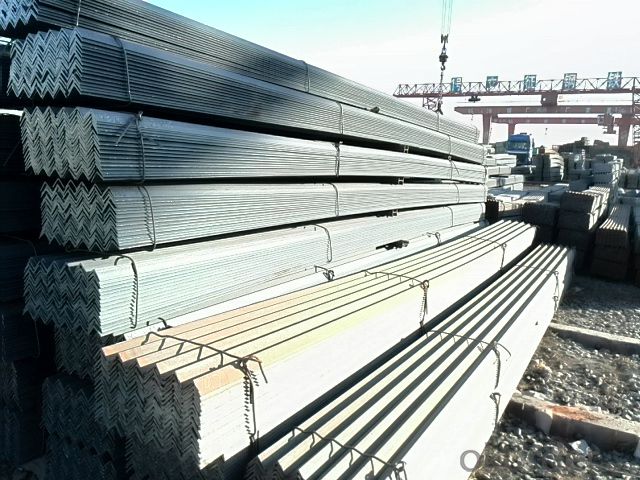
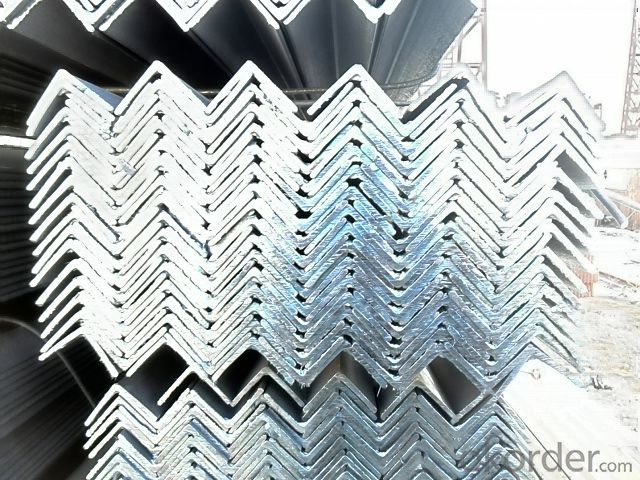
- Q: Can steel angles be used for manufacturing support brackets?
- Yes, steel angles can be used for manufacturing support brackets. Steel angles are commonly used in construction and manufacturing industries due to their strength and durability. They provide excellent support and structural integrity, making them ideal for creating support brackets. Steel angles are available in various sizes and thicknesses, allowing for customization based on the specific requirements of the bracket. Additionally, steel angles can be easily welded, drilled, and machined to fit the desired specifications, making them a versatile choice for manufacturing support brackets.
- Q: Can steel angles be used for architectural purposes?
- Yes, steel angles can certainly be used for architectural purposes. Steel angles are versatile structural components that can be used in various architectural applications. They are often used to provide structural support and stability in building construction. Steel angles can be used as lintels or beams to support the weight of walls, roofs, or floors. They can also be used as columns or braces to reinforce the structural integrity of a building. Additionally, steel angles can be used as decorative elements in architectural designs, adding a modern and industrial aesthetic to the overall look of a structure. Their durability, strength, and malleability make steel angles a popular choice for architects and engineers when designing and constructing buildings.
- Q: How do you calculate the bending moment of a loaded steel angle?
- To calculate the bending moment of a loaded steel angle, you need to determine the applied load and the distance from the load to the point of interest on the angle. Then, multiply the load by the distance to obtain the bending moment. This calculation helps determine the strength and stability of the angle under the applied load.
- Q: Can steel angles be used for HVAC ductwork support?
- Yes, steel angles can be used for HVAC ductwork support. Steel angles are commonly used in construction projects for their strength and durability. They provide excellent support for various applications, including HVAC ductwork systems. Steel angles can be easily fabricated and installed to create a sturdy framework for ductwork, ensuring stability and proper functioning of the system. Additionally, steel angles can withstand the weight and pressure exerted by the ductwork and are resistant to corrosion, making them a suitable choice for long-term use.
- Q: Can steel angles be used for support brackets?
- Yes, steel angles can be used for support brackets. They are commonly used in construction and engineering projects due to their strength and stability. Steel angles provide structural support and can effectively bear heavy loads, making them a suitable choice for support brackets.
- Q: What are the different types of steel angles used in door and window frames?
- The different types of steel angles commonly used in door and window frames include equal angle, unequal angle, L-shaped angle, and T-shaped angle.
- Q: How do you calculate the deflection of a steel angle?
- To determine the deflection of a steel angle, one must take into account various factors and utilize the correct formulas. Typically, the deflection of a beam or angle is calculated using the Euler-Bernoulli beam theory, which assumes small deflections and a slender beam. Initially, the moment of inertia (I) of the steel angle needs to be calculated. This can be done by considering the dimensions and properties of the angle section. The moment of inertia reflects the angle's resistance to bending. Subsequently, the applied load or force (F) acting on the steel angle should be determined. This could be a concentrated load, distributed load, or a combination of both. The load induces a bending moment (M) on the angle. Once the moment of inertia and the bending moment are established, the formula for deflection in a simply supported beam can be employed: To calculate the deflection at the midpoint of the steel angle (δ), use the following equation: δ = (5 * M * L^4) / (384 * E * I) In this equation: - δ represents the deflection at the midpoint of the steel angle - M denotes the bending moment applied to the angle - L signifies the length of the angle - E represents the modulus of elasticity of the steel material - I indicates the moment of inertia of the angle section By substituting the appropriate values into the formula, one can compute the deflection. It is crucial to ensure that the units are consistent and compatible during the calculation process. However, it is important to note that this calculation assumes linear behavior and disregards factors like shear deformation and lateral torsional buckling. For more precise results, additional factors should be taken into account or engineering resources, such as design codes or software, should be consulted for a more accurate deflection calculation.
- Q: How do steel angles perform under static or stationary loading conditions?
- Steel angles perform well under static or stationary loading conditions. Due to their structural shape and high strength, they can effectively withstand and distribute loads without significant deformation or failure. Their stability and resistance to bending or buckling make them suitable for various applications in construction and engineering projects.
- Q: What is the weight of a steel angle?
- The weight of a steel angle can vary depending on its dimensions and composition.
- Q: What are the alternatives to steel angles in construction?
- There are several alternatives to steel angles in construction that offer different advantages and disadvantages depending on the specific application. 1. Aluminum angles: Aluminum angles are lightweight and corrosion-resistant, making them a popular choice for outdoor construction projects. They are also easily machinable and have good electrical conductivity. However, aluminum angles may not have the same strength and load-bearing capacity as steel angles, making them less suitable for heavy-duty structural applications. 2. Fiberglass angles: Fiberglass angles are lightweight, non-conductive, and highly resistant to corrosion and chemical damage. They are commonly used in industries where exposure to harsh environments, such as water or chemicals, is a concern. However, fiberglass angles may not have the same strength as steel angles and may require additional reinforcement for heavy loads. 3. Carbon fiber angles: Carbon fiber angles are lightweight, high-strength, and have excellent resistance to corrosion. They are commonly used in applications where weight reduction is critical, such as aerospace and automotive industries. However, carbon fiber angles tend to be more expensive than steel angles and may require specialized manufacturing techniques. 4. Wood angles: Wood angles, typically made from hardwood or engineered wood products, are a traditional alternative to steel angles in construction. They are readily available, cost-effective, and easy to work with. Wood angles are often used in residential and light commercial construction projects. However, wood angles may not have the same strength and durability as steel angles and may be more prone to warping, cracking, or rotting over time. It's important to consider the specific requirements of the construction project, including the load-bearing capacity, environmental conditions, and budget, when choosing an alternative to steel angles. Consulting with a structural engineer or construction professional can help determine the most suitable option for each specific scenario.
Send your message to us
Steel Angle Bars Hot Rolled Source from China
- Loading Port:
- Tianjin
- Payment Terms:
- TT OR LC
- Min Order Qty:
- 25 m.t
- Supply Capability:
- 10000 m.t/month
OKorder Service Pledge
OKorder Financial Service
Similar products
Hot products
Hot Searches
Related keywords
